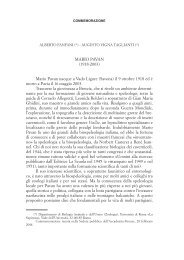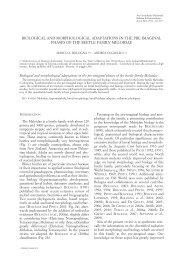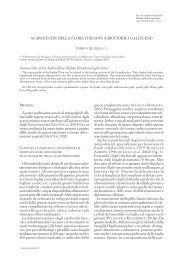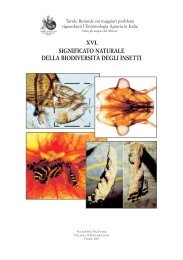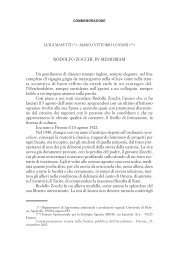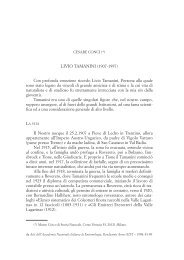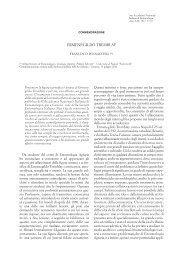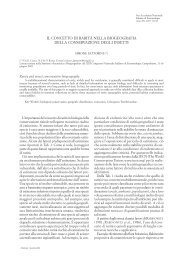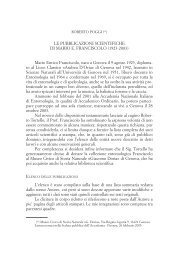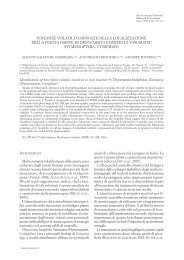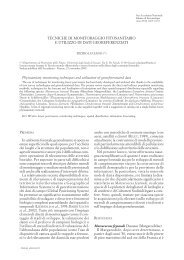XXII CNIE - Accademia nazionale italiana di Entomologia
XXII CNIE - Accademia nazionale italiana di Entomologia
XXII CNIE - Accademia nazionale italiana di Entomologia
Create successful ePaper yourself
Turn your PDF publications into a flip-book with our unique Google optimized e-Paper software.
synergize each other, make the development of alternative approaches to varroa<br />
management in commercial apiculture a high priority.<br />
Nutrition?<br />
Stress caused by poor nutrition has also been suspected to play a role in colony collapse<br />
<strong>di</strong>sorder. The high incidence of CCD among migratory beekeepers suggested that the<br />
practice of maintaining bees for extended periods of time on monofloral food sources<br />
might lead to nutritional imbalances and impaired resistance to <strong>di</strong>sease. Yet another<br />
source of concern was the routine use of sugar water or high fructose corn syrup, in<br />
place of honey, to sustain colonies through the winter; such <strong>di</strong>ets lack the myriad<br />
micronutrients and antioxidants that are present in honey. Johnson (2008), using a<br />
specialized “detoxification” microarray to identify inducers of detoxification gene<br />
transcription, found that, unlike the P450s of most other insects examined, honey bee<br />
P450 genes are not upregulated by synthetic substances or by table sugar; rather,<br />
constituents of honey, propolis and pollen upregulate these genes, demonstrating in a<br />
compelling way the extreme <strong>di</strong>etary specialization for floral tissues exhibited by the<br />
honey bee. The fin<strong>di</strong>ng that sucrose (table sugar) does not upregulate detoxification<br />
genes suggests that fee<strong>di</strong>ng bees sugar water or possibly high fructose corn syrup, both<br />
common apicultural practices, may alter their ability to metabolize pesticides.<br />
Diagnostics<br />
Some of the conflicting evidence regar<strong>di</strong>ng the causes of CCD can be accounted for by<br />
virtue of the fact that <strong>di</strong>agnosis of the con<strong>di</strong>tion is imprecise. Debnam et al. (2009)<br />
developed a 13-item visual inventory of symptoms that constitute evidence of incipient<br />
collapse; although such <strong>di</strong>agnostics are useful in allowing beekeepers to take action to<br />
reduce losses, the characteristic signs vary geographically and temporally and can be<br />
<strong>di</strong>fficult to quantify unambiguously.<br />
By enabling high throughput quantitative analyses of whole genome RNA expression<br />
levels, microarray analyses can be useful <strong>di</strong>agnostic tools (Bustin et al. 2002). Thus, we<br />
recently undertook a whole genome microarray comparison of bees afflicted with CCD<br />
with the objective of identifying a characteristic gene expression profile. Because the<br />
gut is the major site of pesticide detoxification in honey bees (Yu et al. 1984) and is<br />
integral to immune defense against pathogens (Lemaitre et al. 2007), it is likely a target<br />
site for the development of CCD, irrespective of causative agents. We compared gene<br />
expression in guts of adult worker bees from colonies afflicted with CCD with that in<br />
guts of adult workers from colonies sampled prior to the outbreak of CCD. Samples<br />
showing varying degrees of CCD were collected on the East and West Coasts of the US<br />
in the winter of 2006-2007 and compared with healthy controls were collected in 2004<br />
and 2005. Lists of genes <strong>di</strong>fferentially expressed between groups were categorized<br />
accor<strong>di</strong>ng to Gene Ontology (Ashburner et al. 2000) and expression changes of a small<br />
group of genes were verified using quantitative real-time PCR (qPCR) on a separate set<br />
of bees afflicted from CCD that were collected in California in late 2007.<br />
We found remarkable geographic variation in both gene-expression patterns and<br />
pathogen loads. This variation likely reflects the multiple stresses experienced by bees<br />
and underscores the necessity for extensive population surveys for <strong>di</strong>agnostic purposes.<br />
Future work is needed to definitively establish the correlation between picornavirus<br />
pathogen load and polyadenylated rRNA fragment abundance. Ad<strong>di</strong>tionally, the<br />
consequences of viral infection and CCD on the function of ribosomes should be<br />
explored through assays of translational efficiency. In the interim, colony surveillance<br />
via assay of rRNA fragment abundance may provide an earlier in<strong>di</strong>cation of CCD status<br />
than has hitherto been available and allow beekeepers to take actions to reduce bee<br />
losses.<br />
6



